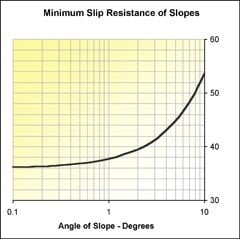Ask the Expert: slip resistance on ramps
Q: I am installing disabled ramp access, what should the slip resistance of the stone finish be?
Approved Document K of the Building Regulations considers a ramp to be a surface that has a minimum slope of 1:20 or 2.9°. It also gives the maximum slope of a disabled ramp as 1:12 or 4.8°. There are no set minimum limits for slip resistance that can be applied to disabled ramps. Instead, the UK Slip Resistance Group guidance provides a simple equation that can be used to convert the minimum slip resistance value given for a horizontal surface to an equivalent for any slope angle. The equation is as follows:
Minimum Slip Resistance Value + [100 x Tangent (Slope Angle)]
Using this equation and a minimum slip resistance value of 36, which meets the >35 value suggested by the Health & Safety Executive for horizontal surfaces, the increase in minimum slip resistance with increasing slope can be plotted on the graph (right).
From the graph it is seen that the maximum slope of 5° increases the minimum slip resistance value to 45 – which is a significant increase. The minimum slope would require a slip resistance value of at least 41.
It is probably easiest to suggest that any properly constructed disabled ramp following the advice of BS 8300 incorporating a stone finish should exhibit a minimum slip resistance of 45 under all conditions of use.
With natural stone, the minimum slip resistance values that have been calculated suggest that a more heavily textured finish than honed should be used for ramps.
This is because it is rare to find honed stone surfaces that maintain slip resistances in the mid to high 40s. Most honed stones in service will settle around 40 – gritstones and some coarse sandstones are notable exceptions – so more heavily textured surfaces should be applied to ensure there is sufficient slip resistance under all conditions. Flame-finished, picked, riven and other similar surfaces should be applied.
If you happened to be building a sloped surface that was not to be used for disabled access then it is advisable not to build this beyond 10° as many textured stone surfaces will have difficulty maintaining slip resistance values in the mid 50s and above. Gritstones and coarse sandstones would probably be the only materials that could be used without risk.
References
BS 8300: 2001. Design of buildings and their approaches to meet the needs of disabled people. Code of practice. Published by British Standards Institution, London, England.
Protection from falling, collision and impact. Approved Document K, The Building Regulations.
Methods for the determination of slip resistance. Guidelines of the UK Slip Resistance Group, Issue 3, 2005.

